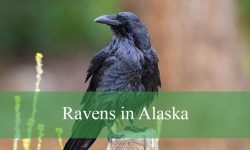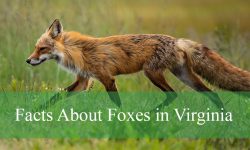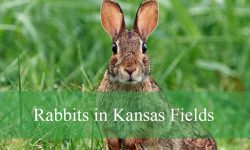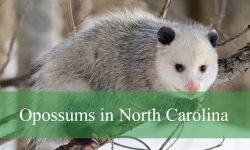Arizona is a land of striking contrasts, with landscapes ranging from sun-scorched deserts to rugged mountain ranges. This diverse environment supports a variety of wildlife, including two types of feral pigs that often capture the attention of residents and nature enthusiasts alike: the native javelina (Tayassu tajacu) and the non-native wild boar (Sus scrofa).
At first glance, javelinas and wild boars may appear similar, both sporting bristly coats and pig-like features. However, a closer look reveals striking differences in their size, behavior, diet, and ecological roles. These distinctions play a key role in how each species interacts with Arizona’s ecosystems.
For those interested in wildlife observation, conservation, or managing feral pig populations, understanding these differences is essential. Recognizing the unique characteristics and habits of javelinas and wild boars can enhance encounters in the wild while promoting informed stewardship of the state’s natural habitats.
Javelina (Collared Peccary)
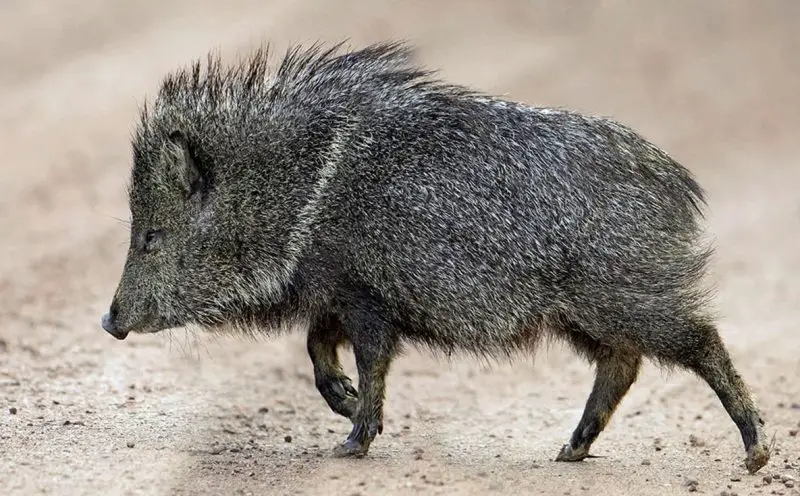
Physical Characteristics
Javelinas are medium-sized, hoofed mammals native to the southwestern United States, with Arizona being one of their primary habitats. They typically stand about 18 inches tall at the shoulder and measure between 32 and 36 inches in length. Adult javelinas generally weigh between 35 and 60 pounds, with males slightly heavier than females.
One of their most distinctive features is the coarse, bristly coat that ranges from dark gray to brown, accented by a white or light-colored “collar” around the shoulders. This collar becomes especially noticeable during the winter months when their fur thickens to provide additional insulation. Their compact, pig-like bodies, short legs, and blunt snout allow them to move easily through rocky desert terrain and dense brush.
Behavior and Social Structure
Javelinas are highly social animals, living in tight-knit groups called “squadrons,” which usually consist of six to twelve individuals. These groups follow a matriarchal structure, often led by an older female who guides foraging and movement patterns.
Communication within the squadron is achieved through vocalizations, such as grunts and squeals, and scent marking, which establishes territorial boundaries and identifies group members. Unlike wild boars, javelinas do not root the ground. They are primarily herbivorous, feeding on prickly pear cactus, mesquite beans, tubers, and other desert plants, which allows them to thrive without causing significant environmental damage.
Habitat and Distribution
In Arizona, javelinas are most commonly found in the Sonoran Desert, particularly in areas with dense vegetation like saguaro cactus forests and riparian zones. They are also present in oak woodlands and grasslands, typically at elevations between 2,000 and 6,000 feet. Their range spans much of southern Arizona, including areas near Phoenix and Tucson.
Reproduction
Javelinas breed year-round, with most litters born between November and March. Females give birth to one or two young, known as “reds,” which are reddish-brown at birth and develop adult coloration by around three months of age. The young remain with the mother until they reach sexual maturity at about ten months.
Predators and Ecological Role
Natural predators of javelinas include mountain lions, bobcats, coyotes, and jaguars. Despite their modest size, javelinas play a vital role in seed dispersal and maintaining the health of desert ecosystems by feeding on a wide variety of plants.
Observing Javelinas
The best times to observe javelinas in Arizona are during early morning or late evening hours, especially in the cooler months. They are often seen near water sources or in areas with abundant vegetation, quietly foraging in small squadrons.
Wild Boar (Feral Hog)
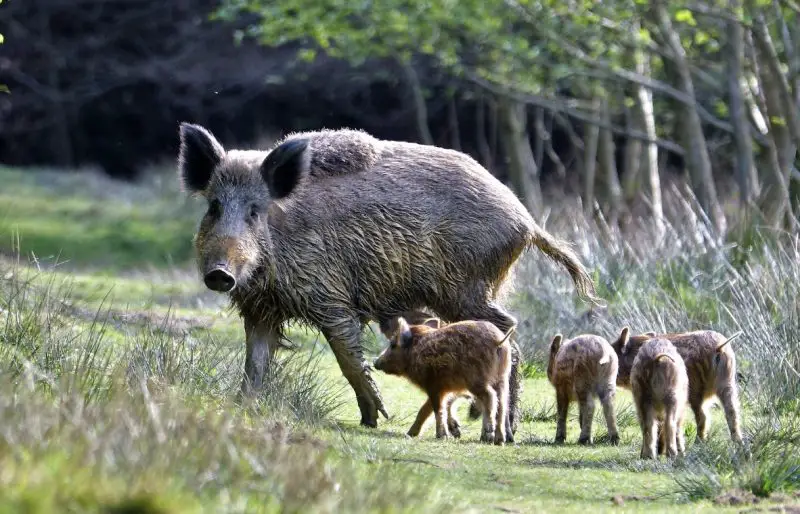
Physical Characteristics
Wild boars are large, muscular mammals with a long, pointed snout and prominent, curved tusks used for digging and defense. Their dense, bristly coat can vary from black to dark brown, often accompanied by a distinctive mane running along their back.
Adult wild boars in Arizona typically weigh between 150 and 300 pounds, with males being larger and more robust than females. Their sturdy build and powerful limbs make them excellent foragers, capable of navigating dense forests, grasslands, and rugged terrain with ease.
Behavior and Social Structure
Wild boars are generally solitary, although females may form small groups with their offspring. They are known for their aggressive nature and can be dangerous if threatened, using their sharp tusks as a primary means of defense.
These omnivorous animals have a highly varied diet that includes roots, tubers, insects, small mammals, and the eggs of ground-nesting birds. Unlike javelinas, wild boars are active rooters, using their powerful snouts to dig through soil in search of food. This behavior, while essential for survival, often leads to significant environmental disturbance.
Habitat and Distribution
Feral hogs are non-native to Arizona, yet they have established populations throughout the state. They are extremely adaptable, inhabiting forests, grasslands, and agricultural lands.
The introduction of wild boars is primarily linked to escapes from hunting preserves and illegal releases, allowing them to thrive in both wild and semi-managed landscapes. Their presence is most noticeable in areas with abundant food and water, which supports their rapid growth and reproduction.
Reproduction
Wild boars are prolific breeders. Females can become sexually mature as early as six months old and typically produce two litters per year. Each litter consists of four to six piglets, contributing to fast population growth and the ability to expand into new territories quickly.
This high reproductive rate is one reason wild boars are considered a problematic invasive species in Arizona.
Predators and Ecological Impact
Adult wild boars have few natural predators due to their size and strength, though young piglets are vulnerable to coyotes, mountain lions, and occasionally bobcats.
Ecologically, wild boars are highly disruptive. Their rooting behavior destroys native plant communities, contributes to soil erosion, and negatively affects water quality. Additionally, they compete with native wildlife for food and can transmit diseases to domestic livestock, posing both environmental and economic concerns.
Observing Wild Boars
Observing wild boars in Arizona can be challenging due to their secretive and nocturnal habits. They are most active during nighttime and early morning hours.
The likelihood of spotting them increases in areas with plentiful food sources, such as agricultural fields, water-rich habitats, or disturbed landscapes where they forage extensively.
Key Differences Between Javelinas and Wild Boars
Feature |
Javelina (Tayassu tajacu) |
Wild Boar (Sus scrofa) |
|---|---|---|
Origin |
Native to the Americas |
Introduced to North America |
Size |
35–60 lbs |
150–300 lbs |
Snout |
Short and spade-shaped |
Long and pointed |
Tusks |
Straight, used for crushing |
Curved, used for digging |
Social Structure |
Live in groups (squadrons) |
Primarily solitary |
Diet |
Herbivorous, occasionally omnivorous |
Omnivorous, includes meat |
Habitat |
Desert and woodland areas |
Various habitats, including forests |
Reproductive Rate |
One or two offspring per year |
Two litters per year, 4–6 piglets each |
Ecological Role |
Seed dispersal, maintains plant health |
Habitat destruction, competes with natives |
Best Times and Locations for Observation
In Arizona, the best times to observe feral pigs are during the cooler parts of the day, particularly in the early morning and late evening. These hours coincide with their most active periods, as they forage for food while avoiding the intense midday heat.
Javelinas are more frequently seen in desert and woodland areas, especially within the Sonoran Desert. They often gather near water sources or in regions with dense vegetation, such as saguaro cactus forests and riparian zones.
Wild boars, on the other hand, are more elusive and tend to inhabit forested regions and areas with abundant food sources, including agricultural lands and disturbed habitats. Both species are generally more active during the cooler months of the year, making fall and winter ideal times for observation.
Fun Facts
Javelinas: Despite their pig-like appearance, javelinas are actually more closely related to camels and llamas than to domestic pigs. Their unique evolutionary lineage makes them a fascinating example of desert-adapted mammals.
Wild Boars: A group of wild boars is called a “sounder.” This social structure is primarily seen among females and their offspring, while adult males are often solitary.
FAQs About Feral Pigs in Arizona
What types of feral pigs are found in Arizona?
Arizona is home to two main types of feral pigs: the native javelina (Tayassu tajacu) and the non-native wild boar (Sus scrofa). While they share some physical similarities, they differ in size, behavior, diet, and ecological impact.
How can I tell the difference between a javelina and a wild boar?
Javelinas are smaller, weighing 35–60 pounds, with a short, spade-shaped snout and a light-colored collar around their shoulders. Wild boars are larger, weighing 150–300 pounds, with a long pointed snout, curved tusks, and a mane along their back. Social structure and diet also differ: javelinas live in groups and are mostly herbivorous, while wild boars are primarily solitary and omnivorous.
Where are javelinas commonly found in Arizona?
Javelinas are most commonly found in the Sonoran Desert, oak woodlands, and grasslands, often near water sources and dense vegetation. They inhabit elevations between 2,000 and 6,000 feet and are frequently seen near Phoenix, Tucson, and surrounding desert areas.
Where are wild boars commonly found in Arizona?
Wild boars are adaptable and can live in forests, grasslands, and agricultural areas. They are often found in forested regions or places with abundant food, including farmlands and areas disturbed by human activity.
When is the best time to observe feral pigs in Arizona?
The optimal times are during early morning or late evening hours, when temperatures are cooler. Both javelinas and wild boars are more active during fall and winter months.
Are javelinas dangerous to humans?
Javelinas are generally non-aggressive and prefer to avoid humans. However, they may defend themselves if cornered or threatened, especially mothers protecting young.
Are wild boars dangerous to humans?
Wild boars can be aggressive, particularly when threatened or if males feel challenged. Their sharp tusks can cause serious injuries, so caution is advised when encountering them in the wild.
What role do feral pigs play in the ecosystem?
Javelinas help with seed dispersal and maintaining plant health in desert ecosystems. Wild boars, however, are considered invasive and can damage native habitats, compete with wildlife for food, and negatively affect soil and water quality.
How do wild boars reproduce compared to javelinas?
Wild boars have a high reproductive rate, producing two litters per year with 4–6 piglets per litter. Javelinas reproduce more slowly, giving birth to one or two offspring per year, known as “reds.”
Can I feed or approach feral pigs in Arizona?
It is not recommended to feed or approach feral pigs, as this can lead to aggressive behavior and create unsafe encounters. Observing from a safe distance is the best practice.

